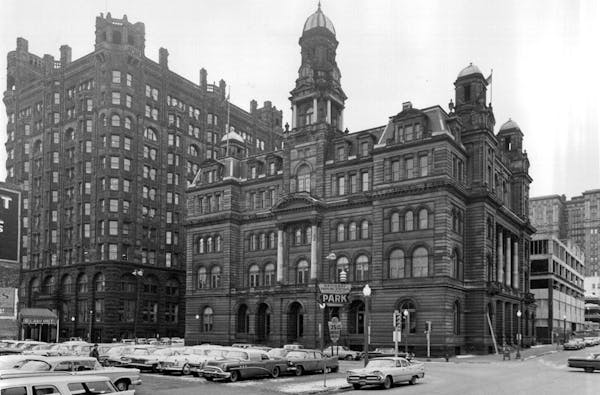Every city has a lost building that remains a source of regret above all others.
New York's great lost building is probably Pennsylvania Station, an early-20th-century masterpiece torn down in 1963.
Chicago remains haunted by the 1972 destruction of Louis Sullivan's Stock Exchange, an event made doubly tragic by the accidental death of photographer and preservationist Richard Nickel as the building was being razed.
In Minneapolis, many still mourn the Metropolitan Building, demolished in the early 1960s, despite pleas from architects, historians and the general public to save it.
What about St. Paul? There are plenty of vanished buildings to choose from, but I'd nominate the Ryan Hotel as the biggest loss to the city.
Completed in 1885 and demolished with minimal fanfare in 1962, the Ryan wasn't quite in the Metropolitan's league as an architectural wonder, but it was a marvelous Victorian Gothic extravaganza with no peers in the Twin Cities.
It was built by Dennis Ryan, who had moved to St. Paul after making a fortune in gold and silver mining in Utah.
Knowing a mark when they saw one, St. Paul business leaders persuaded Ryan to sink about $500,000 into the hotel while they added another $250,000 (led by a $25,000 contribution from James J. Hill).
What drove the project was St. Paul's desire to keep up with Minneapolis, where the luxurious West Hotel — the first truly grand hotel in the Twin Cities — had opened a year earlier.
The seven-story Ryan, at the northeast corner of 6th and Robert streets in downtown St. Paul, fairly hummed with energy, its red brick facades threaded with bands of white stone and decorated with colorful bursts of terra cotta.
Its architect, James J. Egan of Chicago, was an old hand at Gothic drama, and he larded the Ryan's facades with towers, pinnacles, pedimented dormers, bays, bracketed balconies (more than 20 in all), trefoil-arched windows and pretty much anything else he could think of. The result was Victorian street theater at its finest, the kind of eye-catching building that merrily eluded the perils of understatement.
When the Ryan opened in July 1885, the St. Paul Pioneer Press modesty proclaimed it "the equal of any hotel in the world." Maybe not, but it was indeed quite the place. Stretching for almost an entire block along 6th, the hotel offered 335 rooms and suites. Many came with marble mantels and fireplaces, but only about a third offered private bathrooms.
Like the much taller Metropolitan, the Ryan was a "doughnut" building, organized around a central light court measuring 127 by 50 feet. However, the Ryan's court, unlike the Met's, was open to the elements except for a skylit lobby on the ground floor. The lobby was suitably deluxe, featuring stained-glass windows, decorative murals and carved woodwork.
Another of the hotel's signature spaces was an enormous second-floor dining room supported by tall iron columns beneath a gorgeous stained-glass ceiling.
Victorians eclipsed
As was true of so many of its Victorian counterparts, the Ryan began to lose its luster by the early 1900s as new hotels, like the Saint Paul, offered superior accommodations. Even so, the Ryan remained a going concern for many years. Its restaurant was always popular and its rooms and suites were periodically updated.
The Ryan almost vanished in 1923 when new owners from Chicago announced plans to tear it down and replace it with a block-long 15-story hotel. Like many other splendid proposals for downtown St. Paul, the new hotel never materialized, and the Ryan was saved.
By the mid 1950s, the hotel was a genteel but faded establishment, and its owners were losing money, or at least claimed they were. Meanwhile, much of downtown St. Paul was on the cusp of urban renewal, and neither city leaders nor the public at large had much interest in historic preservation.
In late 1961, the Ryan's owners decided to demolish the hotel and possibly build a motel and parking ramp in its place. The motel project proved to be a pipe dream, but the Ryan was nonetheless razed in 1962 after all its furnishings and fixtures were sold at auction.
The destruction of the Metropolitan Building that same year had come only after a huge battle with preservationists, but the Ryan, as far as I can tell, went down with barely a peep of protest despite its architectural and historical significance.
A parking lot initially replaced the hotel, but in 1982 the site was finally filled in with a 21-story office building constructed for the Minnesota Mutual Life Insurance Co. (now Securian Financial Group).
Had the Ryan survived into the 1970s, when the idea of historic preservation finally took hold in St. Paul, the old hotel might well have been restored and renovated. It's easy to imagine the Ryan today as apartments or condominiums, and as a pivotal landmark building linking downtown's central core to Lowertown.
But it didn't happen, of course, and the Ryan turned out to be only one of many superb 19th-century buildings that fell to the wrecker in the 1960s and '70s, as downtown St. Paul modernized itself, with results that were rarely impressive.
Larry Millett is an architecture critic and author of 14 nonfiction books and eight mystery novels. He can be reached at larrymillett.com.











